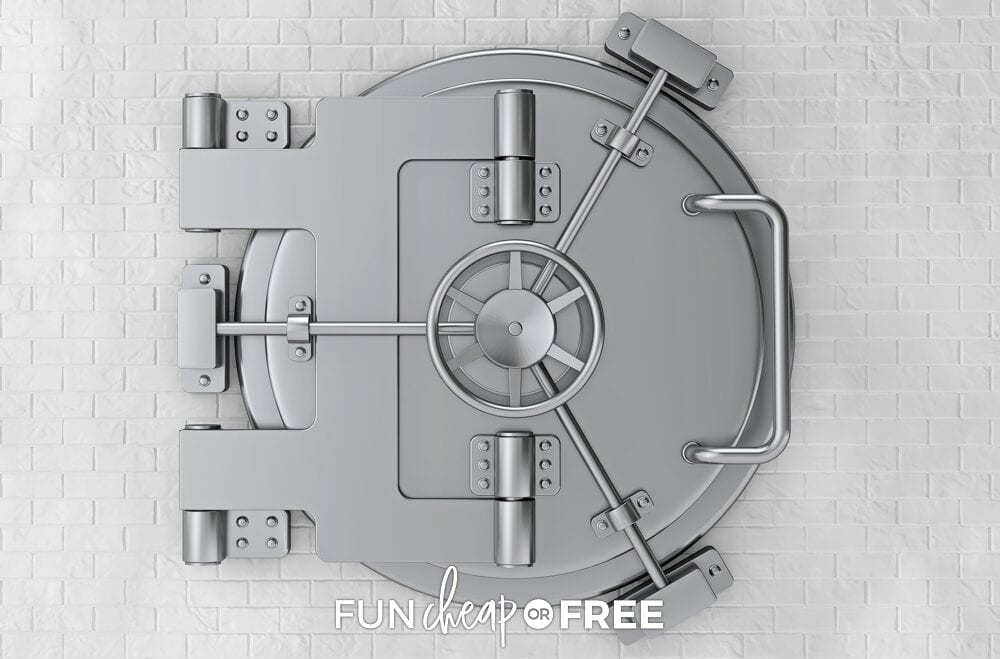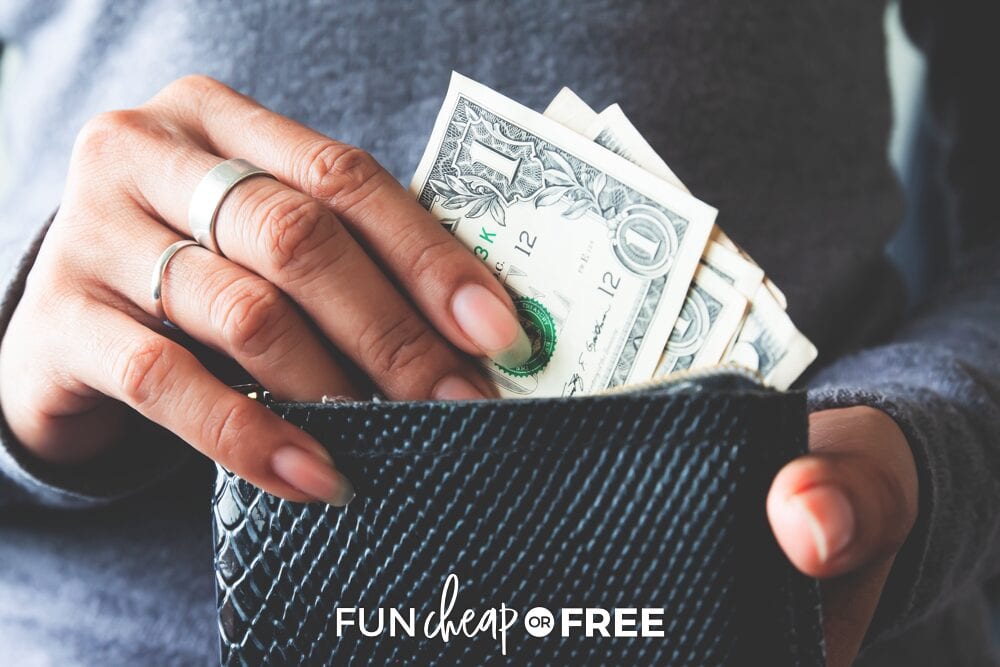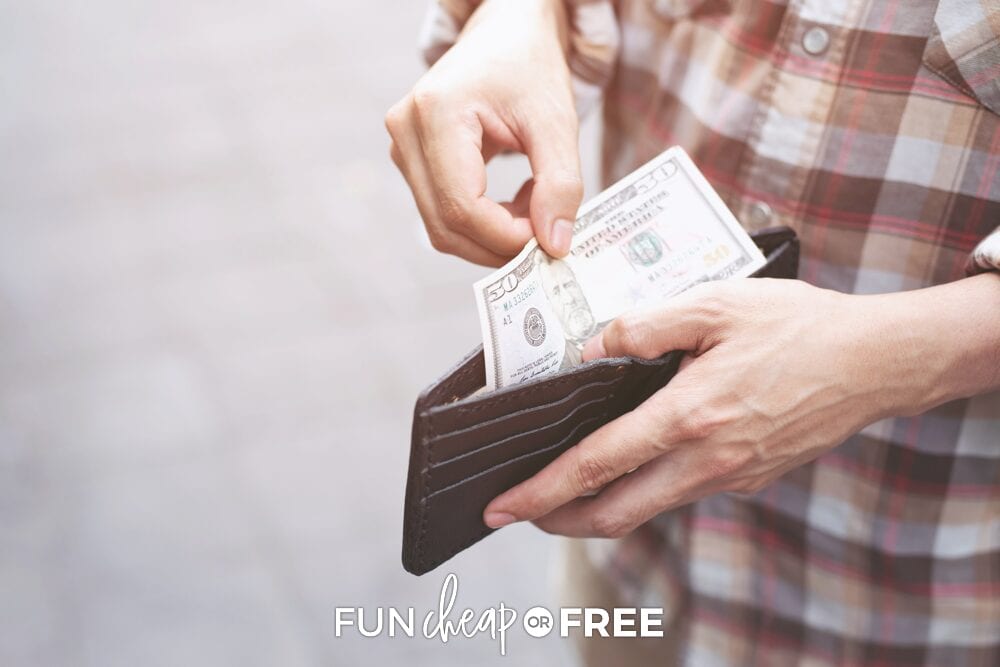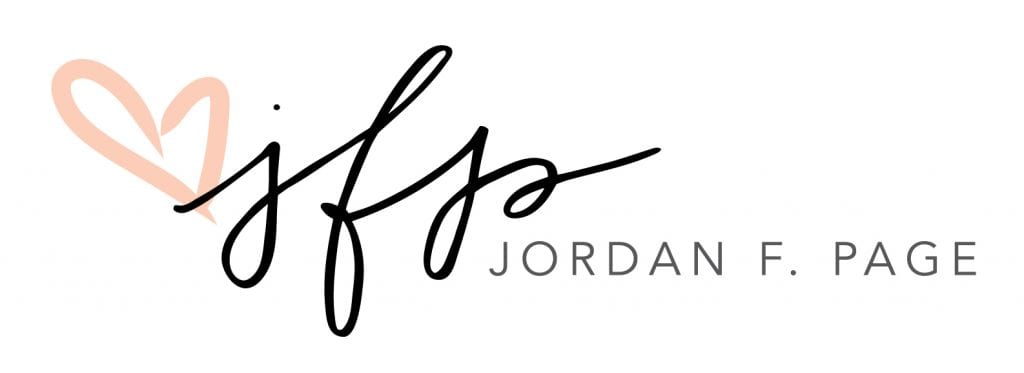Your finances can make or break you, so it's time to get them in order! Organize your money using these top best bank accounts and make it work for you!

Most of us have two bank accounts — one saving and one checking. Have you ever considered opening MORE accounts to help you organize your money better? If not, then you should!
This is one of the single easiest things my husband and I did to get out of our scary financial situation fast. And no, you don't have to have lots of money to do it. In fact, we were living paycheck-to-paycheck at the time and were in the red most months.
*Note: When you click the links in this post, we may receive a commission at no extra cost to you.
This post all started because I did it in a live TV Segment… Which then went viral (it was even featured on LifeHacker)! I hope you are able to find a way to make this system, or something similar, work for your family. If it helps even a fraction of how much it's helped my family, I am happy for you in advance. 🙂 Without further ado, introduce you to…
THE 7 BANK ACCOUNTS YOUR FAMILY SHOULD HAVE
When you file your important papers, you keep them all in the same filing cabinet. But are they in a big pile inside the cabinet? No, they are in multiple filing folders to compartmentalize, organize, and help you keep track of things you need.
So if your papers aren't tossed into one big drawer, why would you toss all your money into one big bank account?
Most families have one savings account and one checking account. This is has been the norm since dinosaurs roamed the earth. Granted, this does work well for many. However, I challenge that having only one or two bank accounts can make it harder to keep track of your money.
The fact is, MOST families statistically have trouble making and keeping a budget. This tells us that the system might just not work that well! Thus, I'm going to propose 7 bank accounts your family should consider opening. These will help you organize your money and save your family thousands!
WATCH MY BANK ACCOUNT VIDEOS
So, wanna know what this is all about? Here is a video summarizing the 7 bank accounts and answering all your questions about them!
Additionally, here is the original TV segment introducing the 7 bank accounts concept years ago:
A FEW NOTES…
First things first… The biggest question I get is: “Doesn't having lots of bank accounts hurt my credit, cost me extra, and make life more complicated for me?”
Simple answer… no. Or, it shouldn't, anyway.
It won't hurt your credit unless you go into debt or don't pay your bills on time. Believe it or not, as confusing as it looks on paper, if you commit to the system, get organized, and take the time to do it right, it will actually simplify your life!
If it costs you money to open an account, CHANGE BANKS. In fact, many banks will pay you to open an account with them! So don't be afraid to change banks. It won't hurt the bank's feelings, I promise.
Before I break down the 7 bank accounts in detail, first a probing question…
HOW DO YOU TRACK 7 BANK ACCOUNTS?
If all of your accounts are with the same bank (most of our accounts are with Chase in our family), then your online bank dashboard will have all your accounts handy in one place.
If your accounts are all open with different banks, you can use Mint.com. It's a free service that pulls information from all your banks and presents them on a single dashboard. They have a fantastic mobile app that my husband loves more than bacon some days. You can even pay bills from Mint.
All in all, if you're willing to use a computer and phone to do your banking rather than a pen and paper, this method will save you time AND money.
Now, here's a further breakdown of the 7 bank accounts highlighted in the video…
FAMILY EMERGENCY SAVINGS BANK ACCOUNT

This is one of the most important bank accounts you can have! As a rule, 20% of your income should automatically go into savings each month. This is the ultimate account for your savings. As a rule, this account is for absolute, dire “we are going to lose our house next week if we don't do something” emergencies. Picture it as the fireproof apocalyptic vault hiding behind concrete walls in your basement, or the piggy bank you have to shatter to open.
You should never touch this account unless it is your absolute last resort! And it should never be for anything that can be resolved in other ways, including paying off debt. Having 6-12 months to live off of is more important than any credit card payment you could ever make! Hopefully, you will never have to touch this account… but good thing you have it if you ever do.
HOW TO USE YOUR EMERGENCY SAVINGS BANK ACCOUNT
- Savings money should be automatically withdrawn from your paycheck every month (20% ideally) and deposited into this account. You should pretend that this money doesn't exist when considering your income/budgets.
- It needs to be an “out of sight, out of mind” account. Don't even bring it up when calculating your money as a family. NEVER consider it as an option for pulling money out of when needing to pay for something, unless it's a literal life-or-death situation.
- You can open this in any savings account. I recommend opening this account through an online bank because it's harder to withdraw money from and is easier to keep “out of sight.” It won't pull up every time you log into your regular bank account, so you won't be tempted to touch the money.
HOW MUCH TO HAVE IN YOUR EMERGENCY SAVINGS BANK ACCOUNT
- You should have enough to live on for 6-12 months. (12 is your goal, but don't stop until you hit at least 6)
- You should aim to put 20% of your earnings into savings every month. Start out by putting 10% into this emergency account, and 10% into your family regular savings account (see next) until that account is built up to 3 months living… Then go back to putting all 20% into this account.
- Ideally, you would never stop depositing 20% of your income into this account. (Unless you were to lose your job and needed that percentage to live off of.)
By having a Family Emergency Savings account that A) you automatically draft money to each month, and B) you NEVER pull money out of, you can effortlessly protect your family from the worst-of-the-worst circumstances.
REGULAR FAMILY SAVINGS BANK ACCOUNT

Note: This now conflicts with the TV segment video slightly since I updated the post. 🙂
This is your “holding tank” account; the savings account that you can tap into when needed. It's used to hold 3-months worth of cash to live off of at all times in case of a short-term emergency.
It's mainly used to hold money you are using to save up for something pre-planned (down payment on a house, new bedroom furniture, major home repairs, family vacation, new car, upcoming wedding, etc.), and to pay for unexpected expenses and emergencies (car repairs, new tires, unexpected home repair, etc.).
HOW TO USE YOUR REGULAR FAMILY SAVINGS ACCOUNT
- Automatically draft 10% from your paychecks to this account every month until the 3 months of cash is saved up, with the other 10% going to your Family Emergency Savings (above).
- Once 3 months of cash is reached, no more automatic deposits from your paycheck into this account. Only deposit leftover money at the end of the month. If you need more money in this account, you're going to have to cut back on your spending throughout the month! You never want to stop depositing the 20% into your emergency savings unless it's an emergency.
- This savings account can be at your normal bank. Try to find a bank that will pay you to open a savings account! You can get paid as much as $75-$150+, just read the fine print and make sure there are no hidden fees.
- You need to have a plan for the money in this account! Don't get in the habit of pulling money out of this account regularly. It needs to be for big purchases that require advance planning, or emergencies only.
HOW MUCH TO HAVE IN YOUR REGULAR FAMILY SAVINGS ACCOUNT
- Since this is the account used to save up for big expenses, the total amount in this account will ebb and flow. However…
- As a rule, always keep a balance of 3-month of living expenses in this account. This gives you money to live off of if needed for a short time before having to tap into your emergency savings.
- When using this account to pay for a big purchase, make sure to save up the full amount before buying.
For example: Let's say I have $15,000 in the Family Regular Savings, which is 3 months to live off of (we're going for easy math, here!). Then, let's say we are anticipating needing $2,500 for a down payment on a car soon. We will need to be patient and save up the full $2,500 BEFORE putting a down-payment down, so that $15,000 remains in there as a constant balance.
Remember, you need that $15,000 for emergencies. It may be to protect you in case you lose your job, or maybe someone needs emergency surgery that insurance won't cover. Don't spend that safety net! By having a Family Regular Savings account, you have a “holding tank” delegated to help you save up for anticipated expenses. It helps you pay for unexpected expenses and protects your family in case you need to live off of savings for a short time.
FAMILY CHECKING BANK ACCOUNT

This is your “home base” account; the account where all paychecks and sources of income go initially. Your money starts here, then is transferred and allocated to other accounts. This is where you pay for minor car/home repairs, oil changes, utilities and all other bills (except for medical bills, more about this below), tithing/donations, and other “family” expenses.
HOW TO USE YOUR FAMILY CHECKING BANK ACCOUNT
- All bills are paid from this account, preferably on auto-pay when possible to avoid late fees.
- Money shouldn't stay for long in this account, because it will be divided up and allocated to other accounts shortly after depositing your paycheck.
- Set up auto-transfers to other accounts to streamline the process of sending your money where it needs to go.
- Once all your money has been deposited to this account and sent where it needs to go, it will be easy to see if you have money left over at the end of the month! A big pat on the back for leftover, unspent money! Any money leftover in this account should go to Family Regular Savings. If you have 3 months of living saved up in that account, have no debt, and don't need to save up for a big expense, then put half of the leftover money into your Slush Fund (below) to save up for something really fun (and put the other half into your Family Regular Savings).
HOW MUCH TO HAVE IN YOUR FAMILY CHECKING BANK ACCOUNT
- Enough to cover your expenses for the month, trying not to have much excess leftover. Any excess money needs to go to debt FIRST, then back to your savings accounts once your debt is paid off. If it sits in your checking account, you will most likely spend it!
- But make sure you have enough in your account that you don't ever overdraw. The best way to figure out how much you need is to look at your spending habits from the last six months. Total up how much you spent every month, minus major emergencies (because that would come from your Family REGULAR Savings, see above). Average it out and start from there.
- Be sure to keep your bank's required minimum amount in this account at all times. Read the fine-print with your bank to make sure you don't get slapped with any fees for not keeping a certain minimum amount in that account.
By having a Family Checking Account as your “home base” account, it makes it easy to send your money to their individual “jobs” (aka other accounts), and makes it simple to see how much money you have leftover (or how much you are short) at the end of the month!
WIFE'S CHECKING ACCOUNT

Wives, I'm talking to you! Your monthly budget drafts from the Family Checking Account (see above) to this account every month. This is the money you spend for the month however you see fit. Whether you use cash, debit card, or credit card, it all comes out of this account.
It makes it easy to keep track of your budget, will make it hard to over-spend, will allow you the autonomy to use your own methods for budgeting and spending for your family, and will give you a place to keep your own “fun money”!
HOW TO USE THIS CHECKING ACCOUNT
- You should use this money to cover your budgeted expenses for the month, which needs to be determined in advance by each individual family.
- Sit down and write out every single thing you spend money on, then divide up spending responsibilities! If you do the cooking, you should buy the groceries since you know what you need. If your husband is the car genius, he should be in charge of paying for car repairs. Whatever you're good at and handle regularly, that's what you should be in charge of. And no, this isn't being sexist in any way! It's not about that at all. It's simply for your family's budgeting purposes so you know exactly who is in charge of paying for what each month! Decide what works for your individual family based on the things you do regularly for your family anyway.
- Once the money has been deposited into your account, you spend the money however you see fit, ensuring you cover all of your responsibilities.
- If you run out of money before the end of the month because of poor budgeting, you need to tighten up and go without until your budget starts over the next month. Consider revamping the budget slightly to give sufficient money to cover all budgeted expenses reasonably if you run out consistently… but dig deep to see if it's spending habits or the budget amount that is the real problem.
- If you have leftover money, rather than spend it you should contribute to your Slush Fund (see below)! Trust me, you'll be happy you did.
- The money for this account should NOT include “family” expenses such as utility bills, home, and car repairs, medical expenses, and large expenses like braces, new furniture, etc. These expenses should be put on auto-pay from the Family Checking account, should come out of the Family REGULAR savings when needed, or from the medical HSA account (see below).
- The money you spend for the month — whether you use cash, debit card, or credit card — all comes out of this account. If you pay for things with a credit card, pay off the card using the money from this account BEFORE you're slapped with any interest fees. If you use cash, divide your budget up weekly (rather than monthly) and pull out exactly what you need each week to pace yourself.
- Whatever is leftover is your fun money! This rewards you for being frugal. So you can decide…”Sure, a $5 pizza would be easy for dinner tonight…but if I save that $10 and cook at home instead, I could go buy a scarf from TJ Maxx instead!” It gives you the freedom to choose. 🙂
HOW MUCH TO KEEP IN THE WIFE'S ACCOUNT
How much you have in the wife's account ultimately depends on your individual family situation! But in general, just enough to cover your financial responsibilities for the month.
A few guidelines for forming this budget:
- Use the envelope budget system method to keep up with this budget.
- A good guide for the grocery budget should be $100 per family member, per month. This includes food, toiletries, baby needs, pet needs… Basically, anything you could find at a typical neighborhood grocery store.
- For everything else (I call this “other”)… and remember that this does NOT include utilities or bills… add up what you've spent money on for the last three months that would apply within the bounds of your spending responsibility, divide it by three to find the average, then knock it down by at least 25%-50%… because we usually spend more than we need to.
HUSBAND'S CHECKING ACCOUNT

All the same rules apply to this account as the Wife's Checking Account. This is the account you use to pay for your budgeted monthly expenses.
By having Husband Checking and Wife Checking accounts, this gives each spouse autonomy to spend however they see fit while still being held accountable for the overall budget amount. It motivates spouses to be frugal where possible, helps allocate spending responsibilities for a family, and makes “who is in charge of what” clear and concise…which leads to less fights about money!
HSA – Health Savings Account
NOTE – Things are changing DAILY with health insurance. Do your due diligence and make sure to stay current. Here is helpful HSA information from the IRS.
An HSA is technically a savings account. I lumped it down here with the checking accounts because you're given a debit card for this account. An HSA is a tax-free savings account built specifically to hold money to pay for any kind of medically-related expense, large or small.
Basically, it's like a normal savings account with a debit card, except this debit card can only be used at pharmacies, doctor's offices, chiropractor's offices, hospitals, and other approved medical facilities. It's a perfect way to set money aside for medical costs. It won't eat into your savings and doesn't have to come out of your wife/husband budgets.
HOW TO USE A HEALTH SAVINGS ACCOUNT
- Go to HealthCare.gov to fully educate you on how these work.
- HSAs work best with more affordable, high-deductible accounts. With lower-deductible accounts, most of your money is going to a premium each month. You pay it, whether you use it that month or not. With a high-deductible plan, you pay for only what you use and it still gives you protection for catastrophic events.
- You get an HSA debit card to be used to pay for every medical expense (and only medical expenses). It's used for anything from a doctor's office co-pay or prescription from a pharmacy, to having a baby or paying off surgery.
- Why use an HSA instead of a standard savings account? Any money deposited into an HSA is tax-free. For those who need a few thousand dollars a year (or more) to cover their family medical costs, this tax savings can be substantial.
HOW MUCH TO HAVE IN A HEALTH SAVINGS ACCOUNT
You should have enough to cover all perceived medical expenses for your family for the year, without depositing too much extra. Obviously, this will vary from family to family. Look at your medical bills for the last year (or even two!) and use that as a place to start. Deposit what you can afford each month.
For my family, we have $400/month automatically withdrawn from my husband's paycheck that goes straight into our HSA… This is in addition to setting money aside in our Family Emergency Savings and Family Regular Savings.
By having a Health Savings Account, it will keep family savings accounts full and organized. It ensures sufficient funds to pay for medical expenses. It prevents having to dip into the Family Regular Savings account to pay off medical bills, and is a great solution for affordable healthcare.
An HSA helps you plan and prepare for expected and unexpected medical expenses. It also allows you to only pay for the healthcare you use and need, all while giving you tax-free savings.
“SLUSH FUND” BANK ACCOUNT

This is your optional 7th account and is definitely one of our favorite bank accounts! Think of this as your spare change jar. This is the account where all extras go. At the end of the month, your debt bills are paid, your 20% has gone into savings, all accounts are accounted for, and you still have extra!
Toss it in here, and this slush fund is your 100% FUN MONEY account! This money does NOT go toward bills or mundane things in any way. Once your debt is paid off, and your savings is under control, this account is your reward for spending wisely. Picture the movie “Up.” They had their Paradise Falls savings jar that they threw their spare change in for years.
But they kept having to break the jar open to pay for emergencies and other things that kept them from ever going to Paradise Falls. Don't let this happen to you! Keep other jars for emergencies, and keep your “fun money” jar for just that, fun money.
HOW TO USE YOUR SLUSH FUND ACCOUNT
You need a plan for this money. It could be for a new TV, vacation, a trampoline, or something else fun that your budget might not allow for otherwise.
- Get your family involved on this goal. Have it be a community fund where any extra money gets contributed toward a common, exciting goal. Make a chart for your fridge, or put pennies in a jar to represent every dollar put in the account. Make it visual, fun, and exciting for the family.
- Sadly, you really should only put money toward a slush fund once your debt is paid off (except your house) and have 6-12 months to live off of between your two savings accounts. But hang in there, take care of your family first, and the fun “extra” money will come soon enough!
HOW MUCH TO HAVE IN YOUR SLUSH FUND ACCOUNT
- This depends on how conservative you are with your spending! This account only holds EXTRA, un-spent funds. The less you spend throughout the month, the more you will have in this account.
- This account may build up very slowly. It may be as simple as $10 leftover in a grocery budget from the week. Or $100 of a tax return that wasn't needed for other accounts, or leftover birthday money that a child wants to contribute. Think of it as your spare change jar that sits in your laundry room. Instead of throwing your ‘spare change' in a jar, throw it in this account!
- Setting a goal for this money is key, so it doesn't burn a hole in your pocket too early!
By having a Slush Fund Account, this encourages a united excitement for spending wisely as a family. It gives everyone a common goal to work for. It allows for a family to spend money on something 100% fun that they might not be able to spend money on otherwise. A slush fund encourages saving, budgeting, and delayed gratification.
KIDS' SAVINGS AND CHECKING BANK ACCOUNTS
Technically, the list could go on to 8 and beyond bank accounts. Since it depends on how many kids you have, I will leave this as “additional accounts.” For every child you have, I propose opening up their own checking and savings accounts.
From day one, you could be drafting a few dollars a year (or however much you can spare) into their savings account. This will help them to save up for college, their future wedding, a religious mission, etc. It's also a great place to deposit their birthday money into it when they're too young to really use or care for money yet.
Once they are old enough to make their own money (allowance, work, babysitting…) you should encourage them to put at least half into savings and to manage the rest into a checking account. Teach them to write checks, use a debit card, the whole nine yards! Yes, even an 8-year-old can understand these concepts if you teach them well enough.
Start your kids off on the right foot. Being financially wise, secure, and comfortable with finances in the real world will take them a long way in their life!
So, there you go!
Rather than tossing all of your money into one savings and one checking account, try opening these 7 (or 8 or 9 or 10…) bank accounts. It may be just the step your family needs to get your budgeting and spending on track!
Let me know how this works for you, I love getting your feedback! 🙂

Check out even MORE budgeting tips below:
- Find the motivation to start budgeting!
- The simplest budgeting method and FREE printables will take you the whole way to crush your budget and money!
- Learn how to budget your money the easy way.
- These budgeting and money management apps will make your life easier!
If you need a little more hand-holding to get your finances in order, then definitely look into my Secret Sauce online budgeting program, Budget Boot Camp! It's a super fun video program that makes money easy to understand. All you need is a screen!
And don't forget, if you don't save at LEAST what you paid for the program, I'll refund every dime. You've got nothing to lose! Use the code FCFBLOG to get an extra 10% off, because I love you 😉
Want more helpful financial articles?
- Learn how to build your credit so you can make purchases when you're ready.
- Find out how credit cards work so you know what you're getting yourself into!
- Get some great tips on how to improve your credit score if you need some help in that department!
- We've got the top reasons that couples fight over money and how to STOP!
Happy banking!


Ok! So it looks like I figured this one out on my own. Yeah me!
Are these accounts with the same bank account?
You can use the same bank; they will be separate accounts, with their own account numbers. You can typically “name” the accounts for easy organization.
I love this idea. It’s simple yet specific!
I have 2 questions.
1. My banks (and all banks that I know of) charge a monthly fee to have a checking account and a minimum amount of money that must be in the savings account in order to not be charged.
I dont have any extra money right now to either pay a monthly fee or have 3/400 sitting in an additional savings account! Is that what is needed for this system to work?
2. After paying off the 2 savings accoints, and paying my monthly bills, I barely have $400 left for monthly groceries for a fsmoly of 4! What to do?
Plz advise!
Ty!
1. Look into online banks. A lot of them have free and no fee accounts with no minimums. Local banks and credit unions can possibly have better programs with multiple accounts as well.
2. I would start your month by paying your bills/putting money aside for your bills, buying groceries, and then putting any money that you have left into savings accounts. Your savings are important, but so is feeding your family and paying your bills!
I’m at a Credit Union. I do not have a monthly fee for checking and I have to keep a minimum of $1 in checking and savings. You may want to look into a Credit Union rather than a bank.
What are your thoughts/experiences with High Yield Savings Accounts?
We’re working on a post about this, so keep checking back! 🙂
Does investments in Roth IRAs count as part of the 20% of savings? I have that automatically drafted each month. Thanks!
Investments like that usually fall into the 10% category. That money is so important to be saving, but it’s not usually money that you could access right now if you needed it in an emergency. If you need more help to answer your questions about the 70/20/10 guidelines, check out THIS post. Hope that helps answer your question! 🙂
What bank do you use for your kids checking and savings accounts?
We use Ally, the online bank, for theirs.
How can I incorporate credit cards into this? A credit score is something I want to build. I plan on only spending what I know I can pay at the end of the month.
You figure out your bank accounts and budgets and then use a credit card to pay for your purchases, rather than cash or a debit card. Then you move the money out of the appropriate bank account/budget to pay for your credit card purchases. As long as you stick to your budget, using a credit card is a great way to build your credit score!
What do you think about having “mattress money”?
If you mean money that you stick under your mattress or keep somewhere else in your house, then it’s a little bit risky from a fire or burglary standpoint. The different bank accounts basically keep that money safe and give it a purpose. What would you be putting that money under your mattress for? An emergency? A vacation? A rainy day? The different bank accounts would keep that money safe for all of those instances, you would just need to store it in the right place. Hope that helps!
I didn’t realize that 20% of your income should go into savings for emergencies. I also like your suggestion of putting it in a separate account, that way it will be harder to just pull it out. I will have to discuss this with my husband, and see if it is something we can start doing.
Jordan, In the video you mentioned a diagram. Do you have a link for the diagram? Thanks
That is exclusively for those who have purchased our Budget Boot Camp program! If that video was helpful for you, then you should definitely check out the program! All of the videos are like that and then have workouts at the end to help you to tailor it to your own personal situation.
I have done the envelope system for awhile and it has helped great to stick to budget. How do you suggest now that alot of places will not take any cash only credit cards? Do you know of a card that is like a prepaid debit card not linked to your bank account. Had credit stollen few times and so it is a concern.
There are prepaid Visas that you can buy at the store, but you usually have to pay an extra activation fee for those. If that’s worth it to you so you don’t have to worry about your bank account or credit card info being stolen, then go for it!
How would you use a single credit card to pay off all these accounts? So for example, our AMEX is linked to our primary checking account, so would we have to transfer all the money from the other bank accounts into the primary checking account in order to pay everything off?
Most credit cards will allow you to have multiple bank accounts you can tie to your credit card to pay on it. If you can add multiple accounts to your card, then you would just pay whatever you needed from that account. If you can only have one bank account tied to your card, then make sure it’s the account that you use the most often (like for groceries and gas). If your primary checking account is mainly your holding tank before the money is automatically sent to the other accounts during the month, then change it out to a different account. You can easily transfer money from other accounts to the account you’ll be using to pay your card as you make those charges (as long as there’s not a set amount of transfers allowed per month). If there are a set amount of transfers, then you would make the transfer as soon as your statement is available so you have plenty of time for the transfers to complete before paying your bill. Hope this helps! It’s really not as complicated as it sounds. 🙂
What do you think of the HONEYDUE APP for couples?
I’m not familiar enough with it to say one way or another, unfortunately! It sounds cool, though. If you try it out, please let us know how it works for you! 🙂
Are all of your accounts at the same bank? If not, how do you transfer money from your “holding tank” automatically to accounts at different banks?
For the most part, yes. That definitely makes it easiest to move money to the different bank accounts that you have!
Hi!
Which account do you recommend to use for Birthday gifts or just gifts in general. I know you mentioned Christmas gifts should come out of one of the savings account. Was wondering if you would also apply that method to gifts in general. Looking forward to your feedback. Thank you so much 🙂
Great question! You could put gift money in your regular family savings account and let that be your gift money holding tank. If that’s too confusing for you, you could also open up a separate account where all gift money goes, for birthdays, holidays, anniversaries, etc. Hope that helps! 🙂
Hi 🙂
I wondering if your kids just have a checking account and a saving account? And how are their accounts build up like? I have saving money for my three kids in ONE big account, and now after reading this to divide up so its easy for them to take after. Any idéas? should I build them up like 7 accounts like you have? and few off them will be empty until they are big enough to learn?
Thanks for this great question! Kids just need 2 bank accounts – one for savings and one for spending. When they get older, they could open more accounts, but there’s no need to now! You’re doing a great job setting them up for success, mama! If you want even more tips on how we teach our kids to manage their money, then be sure to check out our allowance 101 post!
Why do you recommend to have 6-12 months to live off of in your Family Emergency Savings AND Family Regular Savings? Why not just the emergency account?
Hi! We recommend holding 3 months worth of cash in case of a short-term emergency in your Family Regular Savings and enough to live on for 6-12 months in your Emergency Savings.
Could you give more specific examples of what goes in husband and wife accounts? I do cooking and grocery shopping so I understand I would have that money in my account, but not sure about what would go in my husbands account? He’s “in charge” of the vehicle stuff.
Hi Aimee,
Thanks for reaching out! That is definitely something that you two would decide together. Think about what you do day to day and then decide from there, who owns what thing. You can do this!
It’s 2022, so I am a little late to this party, but I have a few questions to pose:
1) Wife and I both buy groceries and cook. Can grocery funds stay in Family Checking instead of going one way or the other? The same applies to fuel money for our vehicles. She works in the same town where we live and shuttles the kids everywhere, but I work out of town and drive through the nearest metro for groceries when she can’t make the run.
2) If I read your bank account info correctly, there really is no need for a “Slush Account” while getting out of debt. While it slows down the repayment of debts, if “some” of the leftover money goes into a “Slush Account” and “some” goes to repayment, it could lead to celebratory milestones along the way, yes?
3) What are your thoughts on using a credit card for budgeted items like groceries and gas that offer rebates/cash back on those items (i.e. the Walmart card that offers 5% cash back for online order/pick-up of groceries)?
4) We use Greenlight for our children’s accounts (17, 14, 10, and 5). Our kids receive allowances for chores, and we can transfer in any money they earn from working outside the home or as gifts. They receive a Visa debit card that we can set limits upon (category, location, and amount). They can also set aside funds for saving inside the account and need parent authorization to move the money from savings back into their debit account.
5) I know you have a family of 10…I have a family of 6. How in the world can you manage a grocery budget on $100 per person per month? I know inflation has been an issue and you have addressed that in some recent videos, but our grocery budget it out of control…by like 2x what you are saying. What do you include in your “grocery” budget? A point of discussion in our house is paper products and household materials…are they included or do they get their own line item?
I thank you for approach to making it seem “down to earth” and realistic. I am trying to use rebate sites and cash back sites, but that alone is like a full time job.
Those are some great questions! Since every situation is so unique, we suggest checking out the Budget Boot Camp to really get into the nitty gritty budgeting questions.
My wife is 3mo pregnant and we have one other child and we are living on one income right now what is the best account for us to open to save but still have disposable income at the end of the month…
Thanks for your question! Each situation is unique so we hesitate to offer specific advice when we only have a snippet of info, but we strongly suggest checking out the Budget Boot Camp for more info!